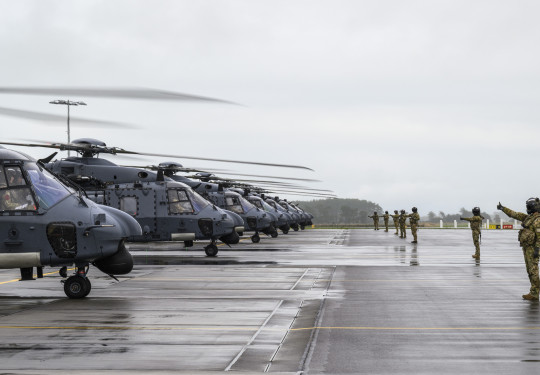RNZAF NH90 fleet’s software upgrade a world first
The Royal New Zealand Air Force’s (RNZAF) NH90 helicopter fleet has just been updated with software and equipment that will now allow the aircraft to better integrate into New Zealand’s controlled airspace – and it was done in record time at Base Ohakea.
28 May, 2025
“We're the first country to do it, and it's happened incredibly quickly,” Capability Development Officer Squadron Leader Austin Smith said.
The fleet’s serviceability rate is the highest in the world, thanks to the work of the squadron’s maintainers, which has assisted in the rapid upgrade across the fleet.
NH Industries’ (NHI) original plan was for the upgrade to be completed by the company’s own technicians in Europe.
The upgrade was initially expected to take three years, from the time the first of eight aircraft left New Zealand to the time the last one arrived back.
However, due to the high work standards undertaken by the New Zealand Defence Force’s Deeper Maintenance team, NHI agreed that the work could be completed at RNZAF Base Ohakea, instead of in Europe.
Furthermore, the Ministry of Defence was successful in securing equipment from an Australian Defence Force’s retired NH90, meaning modifications to New Zealand’s NH90 fleet could be done without grounding the fleet, allowing for the whole upgrade project of eight aircraft to be completed in just four weeks.
One of the advantages of the upgrade is that NH90s can now be identified by coalition forces as a friendly aircraft through the use of modern combat identification, Squadron Leader Smith said.
“The upgrade includes the latest generation of secure inter-aircraft communications, Saturn, to enable secure communications between aircraft in a combat environment.”
Another aspect is the software brings the fleet into compliance with New Zealand Civil Aviation regulations on aircraft identification broadcasts – called ADS-B OUT.
“We've had a dispensation for the Air Force to operate without ADS-B OUT, but this now enables us to operate without restriction.”
The software will also allow the helicopters to automatically maintain a hover position all the way to touchdown, rather than to 15 feet, before it was installed.
This is useful during “brownout conditions” when flying debris, dust or snow whipped up by the rotor downwash leads to poor visibility, Squadron Leader Smith said.
“It also allows us to hover automatically over water lower than previously able, enhancing the safety of activities like Special Forces entering the water from the helicopter.”
Ministry of Defence Domain Director Pete Fitness said the software contract meant the NH90s would be safer to operate.
The requirement to upgrade aircraft which are more than a decade old was to be expected.
While other countries which operated NH90s signed up for the upgrade earlier, New Zealand was the first country to have its entire fleet fitted with the new software, Mr Fitness said.
“In the future we will look at delivering more software and hardware that will enable additional communication functions and performance-based navigation.
“This will allow the helicopter to operate more efficiently in civil air traffic control environments.”
